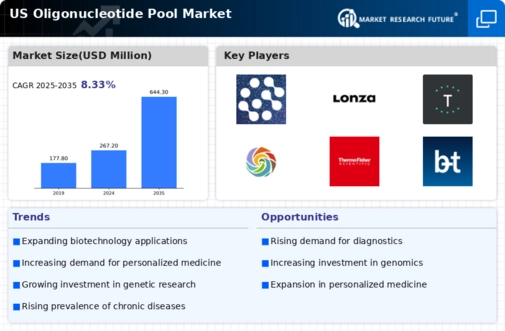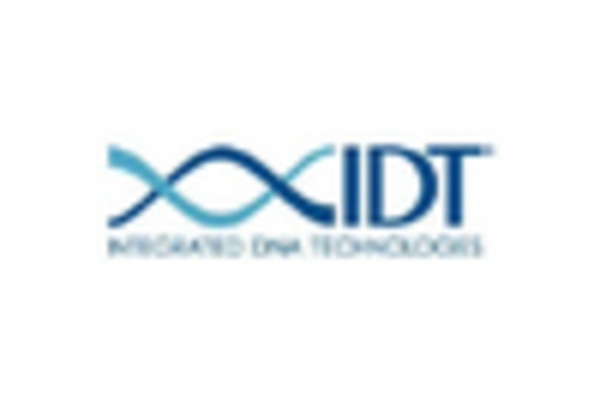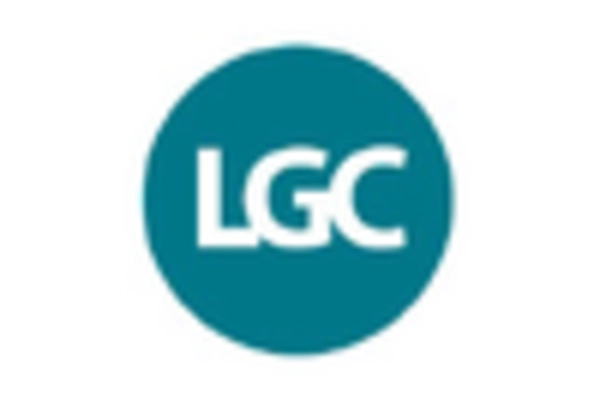Growing Demand for Diagnostic Tools
The oligonucleotide pool market is experiencing an increase in demand for diagnostic tools, particularly in the realm of molecular diagnostics. As healthcare providers seek more accurate and rapid testing methods, oligonucleotide pools are becoming integral to the development of diagnostic assays. The market for molecular diagnostics is projected to reach $11 billion by 2026, with a significant portion attributed to the use of oligonucleotide-based tests. This trend is driven by the need for early detection of diseases, including infectious diseases and cancers. The ability of oligonucleotide pools to provide precise and reliable results positions them as a vital component in the diagnostic landscape. As a result, the oligonucleotide pool market is likely to expand in response to this growing demand for innovative diagnostic solutions.
Expansion of Research Collaborations
The oligonucleotide pool market is benefiting from expanded research collaborations among academic institutions and biotechnology companies. These partnerships are fostering innovation and accelerating the development of new applications for oligonucleotide pools. Collaborative efforts often lead to shared resources, expertise, and funding, which can significantly enhance research outcomes. The National Science Foundation (NSF) has been instrumental in promoting such collaborations, providing grants and support for joint research initiatives. As these partnerships continue to grow, the oligonucleotide pool market is expected to see increased activity in product development and commercialization. This collaborative environment may lead to breakthroughs in therapeutic applications, further driving the market's growth.
Increasing Investment in Biotechnology
The oligonucleotide pool market is experiencing a surge in investment from public and private sectors. In recent years, funding for biotechnology research has escalated, with venture capitalists and government grants contributing significantly. This influx of capital is likely to enhance research and development activities, leading to innovative applications of oligonucleotide pools in therapeutics and diagnostics. The National Institutes of Health (NIH) has allocated substantial budgets for genetic research, which indirectly supports the oligonucleotide pool market. As a result, the market is projected to grow at a compound annual growth rate (CAGR) of approximately 10% over the next five years, driven by these investments. This trend indicates a robust future for the oligonucleotide pool market, as increased funding fosters advancements in technology and product offerings.
Rising Prevalence of Genetic Disorders
The oligonucleotide pool market is significantly influenced by the increasing prevalence of genetic disorders. As more individuals are diagnosed with conditions such as cystic fibrosis, sickle cell anemia, and various forms of cancer, the demand for targeted therapies is on the rise. Oligonucleotide pools play a crucial role in the development of gene therapies and personalized medicine approaches, which are essential for addressing these disorders. According to the Centers for Disease Control and Prevention (CDC), genetic disorders affect approximately 1 in 33 births, highlighting the urgent need for effective treatment options. This growing patient population is likely to drive the oligonucleotide pool market, as healthcare providers seek innovative solutions to manage and treat these conditions effectively.
Technological Advancements in Sequencing
Technological advancements in sequencing technologies are propelling the oligonucleotide pool market forward. Innovations such as next-generation sequencing (NGS) and single-cell sequencing are enabling researchers to analyze genetic material with unprecedented accuracy and speed. These advancements facilitate the development of oligonucleotide pools tailored for specific applications, including gene editing and RNA interference. The market is expected to witness a growth rate of around 12% annually, as researchers increasingly adopt these technologies to enhance their studies. Furthermore, the integration of artificial intelligence in data analysis is likely to streamline the research process, making it more efficient. Consequently, the oligonucleotide pool market stands to benefit from these technological breakthroughs, which are reshaping the landscape of genetic research.

















Leave a Comment